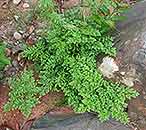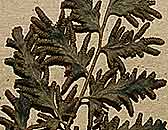Lygodium kerstenii Kuhn
Synonyms |
Lygodium brycei Baker |
|---|---|
Common name |
Climbing fern |
Description |
Rhizome creeping, up to 4 mm wide; rhizome scales linear, blackish-brown, c. 1.5 mm long. Fronds spaced apart, (1–)6–12(–20) m long, up to 48 cm wide. Stipe and rhachis of an elongated frond function as the climbing stem, from which short secondary rhachises at intervals of 7–20 cm, up to 1 cm long with an opposing pair of pinnae arrise, apical bud densely covered with short brown hairs 1.5 mm long. Sterile pinnae 2- to 3-pinnate or 4-pinnatifid on the basal pinnae, margins toothed to lobed; pinnules lanceolate-oblong to lanceolate in outline, up to 11 cm long, simple to 2-pinnatifid, narrowly winged, the ultimate segments acute, usually with prominent basal lobes, crenate, the crenations crenulate, finely hairy along secondary rhachises and the pinnule midribs, veins with scattered hairs on both surfaces. Fertile pinnae bipinnate to 4-pinnate, veins hairy on both surfaces; fertile pinnules lanceolate in outline, up to 9 cm long, simple to 2-pinnate, usually with a long apical segment and shorter basal segments, the margins crenate and with with numerous protruding linear fertile lobes, (2–)4–6(–12) mm long, 1.2 mm wide; sporangia 4-14 pairs, arranged in 2 rows along the margins (pinnule apex without fertile lobes). |
Notes | Differs from L. microphyllum by having hairy veins and more divided pinnae. |
Derivation | kerstenii: named after Otto Kersten ( 1839-1900), a German plant collector. |
Habitat | Fringes of evergreen forest, along rivers in riverine forest or woodland, warm areas with high rainfall. |
Distribution worldwide | Africa, Comores and Madagascar. |
Distribution in Africa |
|
Growth form |
Climbing, terrestrial. |
Literature |
|





